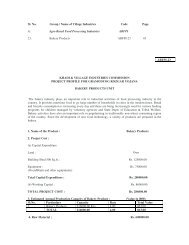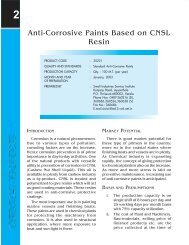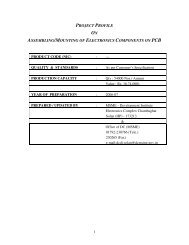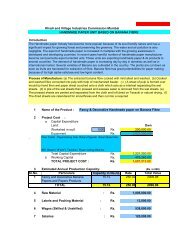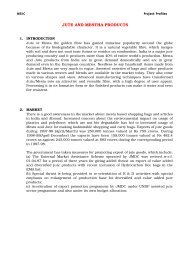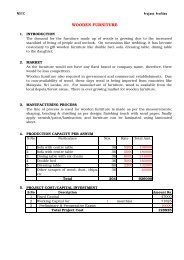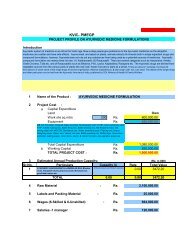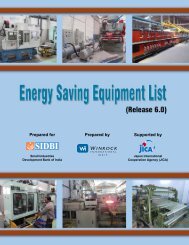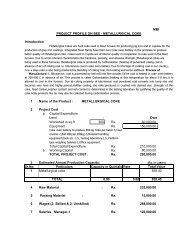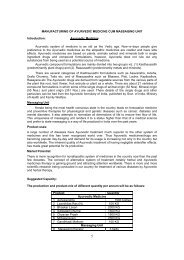Create successful ePaper yourself
Turn your PDF publications into a flip-book with our unique Google optimized e-Paper software.
14<br />
<strong>JACKFRUIT</strong> <strong>PRODUCTS</strong><br />
PRODUCT CODE : No specific code is available.<br />
QUALITY AND STANDARDS : The unit may produce the products as per<br />
specifications available in F.P.O. Rules 1955 and<br />
amendments therein and the Prevention of Food<br />
Adulteration Act, 1955.<br />
PRODUCTION CAPACITY : Qty. : 100 MT, Value : Rs. 71,25,000 per annum.<br />
MONTH AND YEAR : March, 2003<br />
OF PREPARATION<br />
PREPARED BY : Small Industries Service Institute<br />
H. Thangmawizuala Building, Republic Road,<br />
Aizwal (Mizoram)-796001<br />
Phone No.:0389-2323448<br />
INTRODUCTION<br />
The jackfruit botanically known as<br />
Artocarpus heterophyllus lam, one of<br />
the popular fruits of India, is believed to<br />
be indigenous in our country. It is grown<br />
extensively in the west coast, Assam,<br />
West Bengal, Orissa and Bihar. The name<br />
jack is said to be an adoption of<br />
Portuguese ‘Jaca’ which in turn is<br />
believed to have originated from<br />
Malayalam name of the fruit, namely<br />
‘Chakka’. Among the other Indian<br />
names of the fruit are: Pansa (Sanskrit<br />
and Telagu), Katahal (Hindi), Phanas<br />
(Marathi), Pala (Tamil), Halasu (Kannada).<br />
Fully ripe jackfruit is sweet and has an<br />
exotic flavour. The bulbs (edible flakes)<br />
contain 7.5% sugar on dry weight basis<br />
and a fair amount of Carotene (Vitamin<br />
A). The seeds are rich in Carbohydrates<br />
and also a good source of Vitamins. Ripe<br />
fruits are used for nectar and jams. Unripe<br />
fruits are also used for culinary<br />
preparations like chips, pickles, etc.<br />
MARKET POTENTIAL<br />
There is a prospective market for<br />
these products in Kerala as well as<br />
outside the State. It is also learnt that<br />
there is a good export market potential<br />
for these items especially in Middle East<br />
countries. In view of the above, it is<br />
envisaged that there is a good scope<br />
for setting up jackfruit processing units<br />
in jack growing areas. This will not only<br />
help the farmers to utilize the perishable<br />
raw material but also generate more<br />
employment opportunities in rural areas.<br />
About twenty to twenty five units are<br />
engaged in unorganized sector<br />
manufacturing jack chips and jackfruit<br />
preserves.<br />
BASIS AND PRESUMPTIONS<br />
1. The unit proposes to work atleast<br />
200 days per annum on single<br />
shift basis. However, the
<strong>JACKFRUIT</strong> <strong>PRODUCTS</strong><br />
85<br />
production activity will be<br />
available only for 6 months.<br />
2. The unit can achieve its full<br />
capacity utilization during the 3rd<br />
year of operation.<br />
3. The wages for skilled workers is<br />
taken as per prevailing rates in<br />
this type of industry in Kerala.<br />
4. Interest rate for total capital<br />
investment is calculated @ 14%<br />
per annum.<br />
5. The entrepreneur is expected to<br />
raise 20 - 25% of the capital as<br />
margin money.<br />
6. The unit proposes to construct<br />
own building as per F.P.O.<br />
specifications while the cost of<br />
construction is based on local<br />
enquiry.<br />
7. Costs of machinery and<br />
equipments are based on pricelists<br />
received from machinery<br />
manufacturers.<br />
TECHNICAL ASPECTS<br />
Process of Manufacture<br />
Canned Jackfruit<br />
The crisp bulbs of the ripe Jackfruit<br />
are used for canning in sugar syrup.<br />
Yield of bulbs varies from 20 to 25 per<br />
cent depending upon the weight of fruit.<br />
After cutting the fruit in several pieces,<br />
the bulbs are removed with hand. As<br />
the fruit contains a white highly sticky<br />
latex, a little gingili oil or any vegetable<br />
oil is smeared on the hands as the latex<br />
is soluble in the oil. The seeds are<br />
removed from the bulbs. The bulbs are<br />
then canned either as whole or as halves<br />
or quarters. Syrup of 40ºB with 0.5%<br />
citric acid is used to increase acidity level<br />
as the PH value of the fruit is very high<br />
(5.2). The canned jackfruit has an exotic<br />
flavour and is relished by all sections.<br />
The outer skin of the fruit which is a<br />
waste material is rich in pectin. This can<br />
be used for the preparation of pectin. A<br />
good jelly can be also made out of the<br />
peel, and the inner part of the fruit. The<br />
seeds are used as vegetable in every<br />
preparation.<br />
Jackfruit Nectar<br />
The bulb are removed from ripe<br />
jackfruit and passed through a pulping/<br />
fruit mill. They are then mixed with about<br />
10% hot water and passed through a<br />
pulper having a fine sieve of 1 mm hole.<br />
The pulp is used for preparing nectar.<br />
Jack Chip<br />
Raw jackfruit is the basic raw material<br />
for fried jack chips. First of all, raw jack<br />
fruit are cut into large pieces. The bulbs<br />
are then removed with hand. The seeds<br />
are also removed. The raw bulbs are<br />
then cut into suitable length wise pieces.<br />
These pieces are fried in coconut oil or<br />
refined vegetable oil. Salt may be added<br />
to the frying pieces to enhance its taste<br />
and preservation. They are packed in<br />
polythene bags and sealed with sealing<br />
machine.<br />
Quality Control and Standards<br />
The products envisaged in the project<br />
are governed by F.P.O. Rules 1955. The<br />
manufacturer has to obtain F.P.O.<br />
license from the Ministry of Food<br />
Processing, Government of India. Since<br />
this project has a maximum annual<br />
capacity of 100 MT, the unit is<br />
categorized as small scale ‘A’ unit as<br />
per FPO terminology. The product<br />
should also comply with PFA standards<br />
and GMP (Good Manufacturing Practices).
86<br />
<strong>JACKFRUIT</strong> <strong>PRODUCTS</strong><br />
Production Capacity (per annum)<br />
(a) Quantity : 100 MT<br />
(b) Value : Rs. 7,12,5000<br />
Motive Power<br />
FINANCIAL ASPECTS<br />
A. Fixed Capital<br />
(i) Land and Building<br />
15 KW<br />
Amount<br />
(In Rs.)<br />
Land - 250 Sq.mtr. 65,625<br />
Built up Area<br />
Finished goods and raw materials 3,00,000<br />
godown, office etc. 100 Sq.mtr.<br />
@ Rs. 3000 per sq. m.<br />
Working shed including, 3,00,000<br />
concrete storage tanks -<br />
height 14',area 100 Sq.mtr.<br />
@ Rs. 3000 per sq.m.<br />
Total Cost of Land and Building 6,65,625<br />
(ii) Machinery and Equipment<br />
Sl. Description<br />
No.<br />
Qty. Amount<br />
(In Rs.)<br />
1. Baby boiler 200kg. of steam 1 60,000<br />
per hour<br />
2. 100 lit, cap. Steam jaketted 1 16,500<br />
kettle of S.S. Construction<br />
3. Straight feeding exhaust box 1 25,000<br />
with 2 HP motor, starter<br />
and gear box.<br />
4. Sterilization tank (local make) 2 6,000<br />
5. Semi-automatic can sealer 1 40,000<br />
with 301, 401 chucks, roller etc.<br />
6. Can body reformer with motor 1 15,000<br />
and starter<br />
7. Can body flanger with motor 1 10,000<br />
and starter<br />
8. Fruit mill with 2 HP motor 1 17,000<br />
starter with blade and sieves<br />
suitable for jackfruit<br />
9. Wooden basket press 1 5,000<br />
Sl. Description<br />
No.<br />
Qty. Amount<br />
(In Rs.)<br />
10. P.P. Cap sealing machine 1 8,000<br />
11. Work table with aluminium top 2 7,000<br />
12. Frying pans 2 7,000<br />
13. Plastic bag sealing machine 2 1,500<br />
14. Wooden Tables 2 2,500<br />
15. Plate form weighing machine 1 3,500<br />
16. Counter scale balance 2 1,500<br />
17. Storage containers made of 100 17,000<br />
food grade plastic 50 kg<br />
capacity for pickles<br />
18. Storage container made of 40 18,000<br />
food grade plastic 300 lit.<br />
cap for Pulp juice<br />
19. Knives and other factory utensils LS 7,000<br />
20. Testing equipment like LS 9,000<br />
refractometer, salinometer,<br />
pH meter, pipette, Burette<br />
21. Transportation, erection and 2,500<br />
electrification<br />
22. Tax insurance charges LS 15,000<br />
Total 3,16,500<br />
Cost of office equipments 20,000<br />
and furniture<br />
Total 3,36,500<br />
(iii) Pre-operative Expenses 15,000<br />
Total Fixed Capital (i + ii + iii) 10,17,125<br />
B. Working Capital (per month)<br />
i) Personnel<br />
Sl. Designation No. Salary Total<br />
No. (In Rs.) (In Rs.)<br />
1. Food Technologist- 1 5000 5000<br />
cum-Manager<br />
2. Production Supervisor 1 3000 3000<br />
3. Skilled Workers 2 2000 4000<br />
4. Clerk-cum-Store Keeper 1 2000 2000<br />
5. Unskilled Workers 10 1500 15000<br />
Total 29,000<br />
Perquisites @ 15% of Salary 4350<br />
Total 33,350
<strong>JACKFRUIT</strong> <strong>PRODUCTS</strong><br />
87<br />
ii) Raw Material including Packaging Material<br />
Requirement<br />
Sl. Particulars Qty. Rate Amount<br />
No. (In Rs.) (In Rs.)<br />
1. Jackfruit (ripe) 25 MT 1500 37500<br />
2. Jackfruit (raw) 16 MT 1500 24000<br />
3. Sugar and Jaggery 4 MT 15000 60000<br />
4. Citric acid, pectin, LS – 6000<br />
colours and<br />
chemicals<br />
5. Vegetable oil 30 MT 20000 600000<br />
6. Salt, vinegar LS – 2500<br />
and spices<br />
7. A 2-1/2 size 4920 Nos 10 49200<br />
can<br />
8. Jam/pickles 13350 Nos. 5 66750<br />
bottle (500<br />
ml cap.)<br />
9. Nectar, syrup 6140 Nos. 5 30700<br />
bottle (680 ml<br />
cap)<br />
10. 58 mm caps 13350 Nos. 1 13350<br />
11. 31.5 mm caps 6140 Nos. 0.50 3070<br />
12. Labels 24500 Nos. 0.40 9800<br />
13. Printed 6670 Nos. 1.50 10005<br />
polythene<br />
bags<br />
14. Packaging 1100 Nos. 8 8800<br />
cases<br />
Total 9,21,675<br />
iii) Utilities<br />
Amount (In Rs.)<br />
Power 3900<br />
Fuel and Water charges 5000<br />
iv) Other Contingent Expenses<br />
Total 8,900<br />
Amount<br />
(In Rs.)<br />
1. Repair and maintenance 2,000<br />
2. Postage, stationery and telephone 1,500<br />
3. Transportation charges 3,000<br />
4. Advertisement and Publicity 3,000<br />
5. Other miscellaneous expenses 1,500<br />
Total 11,000<br />
v) Total Recurring Expenditure Amount<br />
(In Rs.)<br />
1. Personnel 33350<br />
2. Raw material 921675<br />
3. Utilities 8900<br />
4. Contingent expenses 11000<br />
Total 9,74,925<br />
(vi) Total Working Capital<br />
(on 2 months’ basis) Rs. 19,49,850<br />
C. Total Capital Investment<br />
Amount (In Rs.)<br />
Fixed Capital 10,17,125<br />
Working Capital 19,49,850<br />
Total 29,66,975<br />
FINANCIAL ANALYSIS<br />
Raw materials are seasonal. Hence,<br />
only raw material for six months has<br />
been taken into consideration.<br />
1) Cost of Production (per annum) Amount<br />
(In Rs.)<br />
1. Cost of raw materials (6 months) 5530050<br />
2. Salary and wages 400200<br />
3. Utilities for 6 months 53400<br />
4. Other contingent expenses 132000<br />
5. Depreciation of building @ 5% 30000<br />
6. Depreciation of machinery 31650<br />
and equipment @ 10%<br />
7. Depreciation on office 4000<br />
furniture @ 20%<br />
8. Interest on total capital 415377<br />
investment @ 14%<br />
2. Turnover (per year)<br />
Total 65,96,677<br />
Sl. Item Qty. Rate Total<br />
No. (MT) per MT (In Rs.)<br />
1. Canned jackfruit 25 80000 20,00,000<br />
2. Jack jam/preserve 25 65000 16,25,000<br />
3. Jack nectar/ 25 50000 12,50,000<br />
jack syrup
88<br />
<strong>JACKFRUIT</strong> <strong>PRODUCTS</strong><br />
Sl. Item Qty Rate Total<br />
No. (MT) per MT (In Rs.)<br />
4. Jack pickles 15 70000 10,50,000<br />
5. Jack chips 10 120000 12,00,000<br />
Total 71,25,000<br />
3. Net Profit (per year) Rs. 5,28,323<br />
4. Net Profit Ratio 7.4%<br />
5. Rate of Return on Investment 17.80%<br />
6. Break-even Point<br />
i) Fixed Capital Amount (In Rs.)<br />
(a) Depreciation on machinery 65650<br />
equipment and building<br />
(b) Interest on total Investment 415377<br />
(c) 40% of salary and wages 160080<br />
(d) 40% of other contingent expenses 52800<br />
Total 6,93,907<br />
ii) Net Profit (per year) Rs. 5,28,323<br />
B.E.P. = FC × 100<br />
FC + NP<br />
= 56.7%<br />
Addresses of Machinery and<br />
Equipment Suppliers<br />
1. M/s. Batliboi and Company Ltd.<br />
P.B. No. 3066,<br />
Old Railway Station Road,<br />
Kochi-682018.<br />
2. M/s. B. Sen Barry and Co.<br />
65/11, New Rohtak Road,<br />
Karol Bagh,<br />
New Delhi-110005.<br />
3. M/s. H and P Industries<br />
Near Mundupalam Junction,<br />
Thrissur -110006.<br />
4. M/s. Raylons Metal Works<br />
P.O. Box No. 17426,<br />
JB Nagar, Andheri (E),<br />
Mumbai - 400059.<br />
5. M/s. Laxmi Boilers<br />
2453-B, Karkmpatta Road,<br />
Pallimukku,<br />
Cochin-682016.



